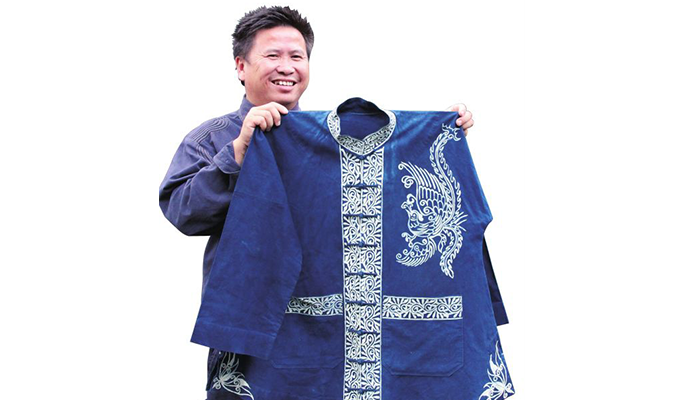Printing and Dyeing Techniques of Liquidambar formosana
Printing and Dyeing Techniques of Liquidambar formosana
Maple fragrance dyeing and production technology, Guizhou Huishui County, Majiang County, local traditional skills, one of the national intangible cultural heritage.
Maple fragrance dyeing production process is complex, generally through pattern drawing, pattern coloring, dyeing vat dipping, high temperature degreasing, rinsing and drying and other processes, the final production of Maple fragrance dyeing products.
On June 7, 2008, the technology of Fengxiang dyeing was approved by the State Council of the People's Republic of China and selected into the second batch of national intangible cultural heritage list, item number_-108.
historical origin
Historic Origin of Maple Fragrance Dyeing Technology in Huishui County, Guizhou Province
From the fifth year of Emperor Qiande (967) to the second year of Emperor Yuanfu (1099), Nanning Prefecture (now Huishui) sent 13 tributes to Beijing (now Kaifeng). The tribute was batik. "Song History" 493 volumes: "Nanning specialty horses, cinnabar... Batik cloth...". It can be seen that the batik dyeing process in Guizhou was mature in the Song Dynasty, and the maple fragrance dyeing process was developed under the influence of the batik dyeing process. From the perspective of materials, tools, decorations and production technology, the maple fragrance dyeing in Huishui County has independent technological characteristics and aesthetic value.
According to the survey of Fengxiang dyeing artists in Huishui County, Guizhou Province, there are three generations of Fengxiang dyeing artists from Yang Zhengxin, the first generation of Fengxiang dyeing artists born in the four years of Guangxu in the Qing Dynasty (1878). So far, it has a history of more than 100 years, but there should be a historical continuity relationship before, and its origin should be earlier.
Historic Origin of Maple Fragrance Dyeing Technology in Majiang County, Guizhou Province
According to some historical records of Qian Ji, Kangxi Tong Zhi of Guizhou and Duyun County Zhi Manuscript, during the Hongwu Period of the Ming Dynasty, a Yao ancestor moved from rotten soil to Duyun Jichang, then to Niuchang, and finally settled in Heba area of Majiang County. Yao people in the territory "live in deep mountains" and "in poor valleys", historically known as "Suixi Valley Group", therefore, the economic characteristics of mountainous areas are prominent, and the economic development is slow down. Clothing mainly depends on cotton seed spinning, self-weaving, self-dyeing, self-made. The Yao people in Majiang County were skilled in Maple scent dyeing hundreds of years ago.
Maple incense dyeing and handicraft in Majiang County has been going on for hundreds of years without interruption. They all originate from the needs of folk customs in popular areas and are part of the daily life of local people. Maple fragrance dyeing has been produced in folk production, and is still processed and used in many ethnic areas today. For a long time, its handicraft has always maintained the traditional method, and has not changed.
Process characteristics
Characteristics of process materials
Maple oil is an important raw material for maple fragrance dyeing. The maple wood which can secrete Maple oil is red, and its leaves turn red in autumn. The method of extracting Maple oil is similar to cutting rubber. Cut the outlet on the maple tree with a knife and axe, and the maple oil will flow out. After being accepted by the container, add water to boil on the fire, filter the residue with filamentous brown skin, and wait for the maple oil to float on the water surface, then cool and solidify.
Maple oil also needs butter as a material, which has two functions: adding butter to Maple oil can increase toughness, and it is easy to remove grease after dyeing. Butter and maple oil are blended in a ratio of 1:1, and then the blended oil is solidified for ready use.
Color and Patterns
Blue and white are the soul elements of traditional Maple fragrance dyeing. The natural combination of simple indigo dyes and maple butter, or white or white flowers on blue background, together with the natural ice crack effect, makes the rhythm of maple fragrance dyeing as different as blue and white porcelain. It is rich and light, and exudes the elegant style of humanistic and natural integration. Liquidambar formosana printing and dyeing pattern is fresh and bright, does not pursue texture effect, fine picture, decorative pattern self-contained system, contains rich traditional cultural connotation, has high practical value and academic research value, is to explore the inheritance and development of national culture rare "unearthed cultural relics".
The patterns are mainly deformed and exaggerated flowers, grass, fish, insects and sparrows, among which geometric patterns, thunder patterns, moires, serrated patterns, etc. Then, dip the bamboo stick in the melted Maple butter butter mixture, and oil the drawing along the pattern. It is called "dot flower". After dot flower, the cloth is dried and dyed. Send the dotted cloth to the dyeing shop in the village for colouring. Generally black or indigo.
Liquidambar formosana dyed products have exquisite design and stable decorative style. They are the manifestation of Guizhou folk arts and crafts. They are different from batik dyeing in other areas of Guizhou by their simple and elegant decorative techniques and unique national handicraft. It bears the blending of historical civilization and modern society as well as the national aesthetic ideal and the desire for a better life, and is recognized by Buyi, Miao and Yao nationalities. Among the Majiang Yao people, many maple fragrance dyed products are put together. They can know which one comes from which family and from whom. What is the historical origin of a pattern and why it should be used are closely related to the historical changes of the nation.
Inheritance and protection
Inheritance value
Fengxiang dyeing has precious research value in national history, humanities, folklore, aesthetics and so on. Yao people have language but no words, and Fengxiang dyeing skills are only taught by mouth and heart. The patterns used are closely related to the historical changes of the nation, and the Fengxiang dyeing technique carries too much historical and humanistic information of the Yao people. Fengxiang dyeing is one of the two main handicraft skills of the Yao nationality. Its process is complex and exquisite, and its design is exaggerated and exquisite. It highly reflects the wisdom and rich imagination, creativity and aesthetic consciousness of the Yao people. Fengxiang dyeing products are mainly used for clothing, straps, quilts, etc. They are magnificent, simple and beautiful, reflecting the traditional character of the Yao people, which is stable and elegant and not well publicized.
Inheritance status
Because of the complexity of maple fragrance dyeing process, long learning cycle, self-spinning cotton cloth, especially hard work and time-consuming, the production cycle can reach half a year, young people are reluctant to learn, coupled with the impact of foreign culture, young people mostly advocate fashion, mostly do not wear their own national clothing, Maple fragrance dyeing products are losing the space of demand, inheritance is scarce, technology is facing a situation of loss of inheritance.
Inheriting characters
Yang Guangcheng, male, Buyi, was born in May 1953. In December, 2012, Yang Guangcheng was selected as the representative successor of the fourth batch of national intangible cultural heritage projects. Huishui County, Guizhou Province declared the project: Fengxiang dyeing production technology.
protective measures
In March 2009, Yang Guangcheng opened an interest class in folk arts and crafts in Yashui Town Primary School, Huishui County. He taught primary school students how to make Fengxiang dyeing and dyeing, and trained more than 200 successive successors. In 2010, an improvement class on Fengxiang Dyeing was opened, with 60 trainees. In July of the same year, Yang Guangcheng selected two young people with slight foundation from each family in his village, who were taught the skills of maple fragrance dyeing three nights a week. He also set up a professional cooperative for maple scent dyeing farmers. Through production, circulation and sales, he pointed out a way for villagers to become rich, revitalized the dying and difficult handicraft of maple scent dyeing, and promoted the development of local economy.
In 2012, the foundation of tourism development of Yao cultural products was established and skills training courses were held, which promoted the development of maple incense printing and dyeing industry in Majiang County, Guizhou Province.
social influence
Important exhibition
In December 2007, a work of Buyi Butter and Maple Fragrance Dyeing was exhibited in Guizhou Province.
In February 2014, at the Symposium on the Protection and Utilization of Maple Printing and Dyeing Techniques, Yang Guangcheng demonstrated the production techniques of Maple Printing and Dyeing on the spot.
Honorary commendation
In 1991, more than 20 Maple fragrance dyed products were collected by the National Museum in Majiang County, Guizhou Province.
In December 2007, a work by Yang Guangcheng Brothers, Buyi Butter and Maple Fragrance Dyeing, was exhibited at Guizhou Folk Arts and Crafts Selection Activity and won the top ten prizes of folk arts and crafts in Guizhou Province.


-
2.Fuping Pottery Art Village
Pottery Village is located in the north of Fuping County. It relies on the site of Tang Dingzhou Kiln. It is a cultural and custom experience scenic spot consisting of a quasi-three-star hotel, three
Time 2019-01-12 -
3.Leiqiong Haikou Volcanic Group World Geopark
Leiqiong Haikou Volcanic Group World Geopark is located in Shishan Town, southwest of Haikou City. It is only 15 kilometers away from the urban area. The Expressway
Time 2019-01-29 -
4.Zamuni of Tibetan Nationality Playing and Singing
"Zamuni" is also called the Six Stringed Orchestra, a traditional Tibetan plucked instrument. Mainly spread in Lhasa, Shannan, Ali, Lazi (Bahir), Sakya, Angren, Dingri and other places
Time 2019-04-15 -
5.Spring Festival
The Spring Festival, the Lunar New Year, is the first year of the year and also the traditional "New Year's Day". Commonly known as New Year, Spring Festival has a long history
Time 2019-04-22 -
6.Mashan folk songs
Mashan Folk Song is a traditional folk song form which is popular in the area of Mashan Town, Jingzhou District, Jingzhou City, Hubei Province. One of China's national intangible cultural heritage lis
Time 2019-05-15 -
7.Mongolian Long tune Folk Songs
Mongolian long-tune Mongolian is called "Uri Tudao", which means long song. It is characterized by fewer words, long-lasting, soothing and free, suitable for narration, and longer lyric.
Time 2019-06-04 -
8.Uygur Daolang Maxi Refu
Maigaiti County is located in the southwest of Xinjiang Uygur Autonomous Region. It is a typical Uygur inhabited area. About 89% of the population is Daolang Uygur who can sing and dance well. Among t
Time 2019-06-26 -
9.Advertising for rent
There are six advertising spaces for each article, first come, first served.
Time 2019-08-30 -
10.Contact information of Chengdu Giant Panda Base
Contact information of Chengdu Giant Panda Base
Time 2020-12-13 -
11.Geomorphological characteristics of Mianyang
The terrain is high in the north and low in the south, and the height difference is large. The northwest of Mianyang City is located in the eastern edge of the Qinghai Tibet Plateau, with high terrain and overlapping peaks. The southwest part belongs
Time 2020-12-14 -
12.Nanchong mineral resources
Nanchong mainly has rock salt, oil and natural gas, placer gold, ferrotitanium, uranium, phosphorus and other mineral resources. Nanchong is located in the core of Nanchong rock basin, the largest rock salt sedimentary basin in Sichuan Province. Underground
Time 2020-12-17